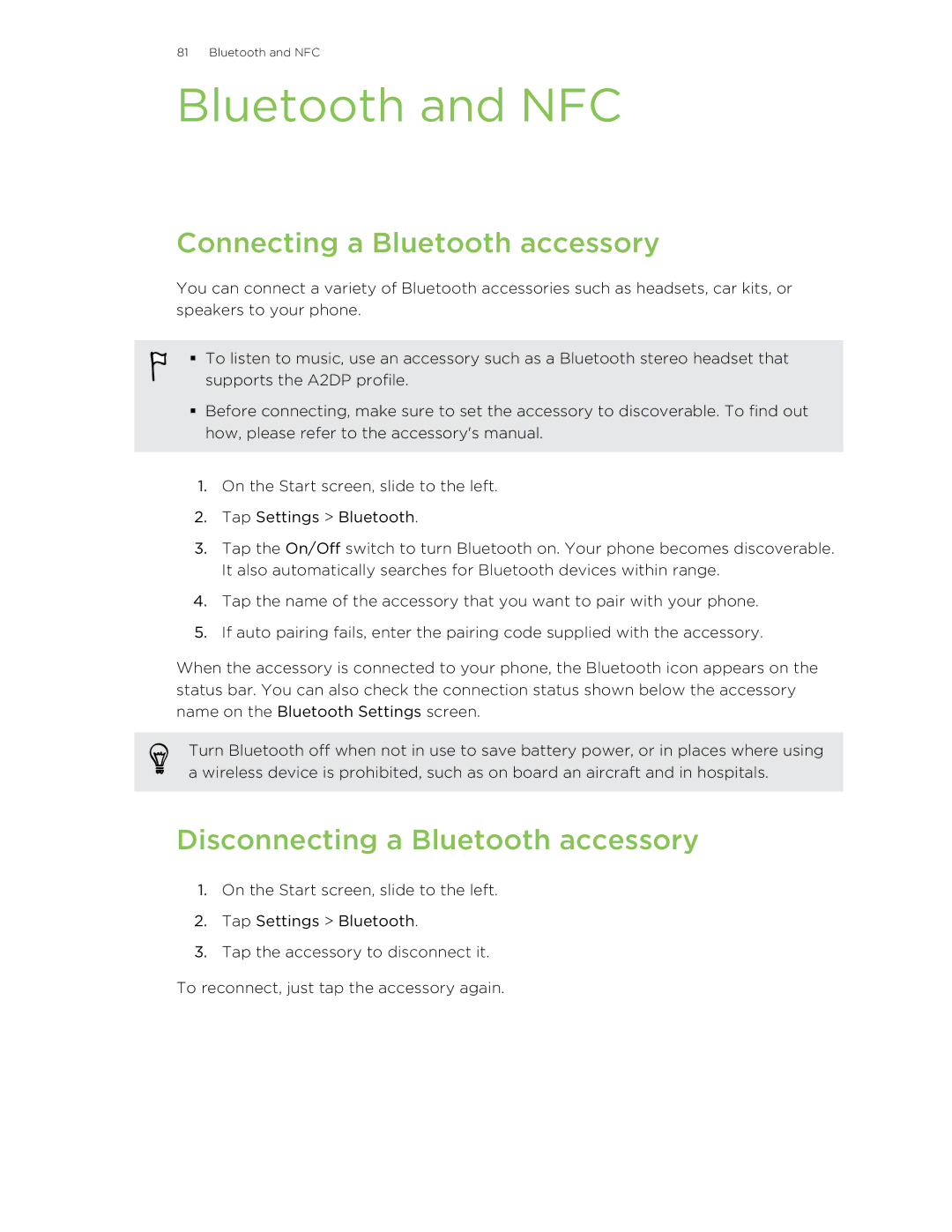Windows Phone 8X by HTC
Contents
Photos, videos, and music
Maps and location
Trademarks and copyrights Index
Conventions used in this guide
Other helpful resources
Your phone
Unboxing
Inserting the SIM card
SIM card
Removing the SIM card
Charging the battery
Battery
Switching the power on or off
Switching the power on
Switching the power off
Setting up your phone for the first time
Setting up your phone
Account setup
Setting up an account
Getting contacts into your phone
Syncing an account
Deleting an account
Your first week with your new phone
Features youll enjoy
Rearranging and resizing tiles
Start screen
Pinning items to the Start screen
Unpinning a tile
Tap
Touch gestures
Drag
Motion gestures
Pick up to lower volume
Silencing your ringer
Adjusting the volume
Switching to Sleep mode
Sleep mode
Waking up from Sleep mode
Lock screen
Changing the ringtone
Changing your lock screen wallpaper
Customizing your lock screen notifications
Switching between apps
Changing the theme
Taking a screenshot
Using speech on your phone
Turning on more speech commands
Windows Store
Your first week with your new phone
Camera
Camera basics
Viewfinder screen
Changing settings
Taking a photo
Zooming
After capturing
Recording video
Making a call
Phone calls
Making an emergency call
Making an international call
What can I do during a call?
Receiving calls
Starting a conference call
Switching between calls
Putting a call on hold
Muting the microphone during a call
Call history
Checking calls in the call history
Clearing the call history
Turning airplane mode on or off
Keeping in touch
People
Importing contacts from your SIM card
Adding a new contact
Filtering your contacts list
Jumping to a section in the contacts list
Merging contact profiles
Unlinking contact profiles
Searching for a contact
Searching, editing or deleting
Editing a contacts information
Deleting a contact
Creating a new room
Sharing with a group of contacts in real-time
Inviting contacts to a room
Rearranging room tiles
Managing a room
Organizing your contacts into groups
Leaving a room
Creating a new group
Removing a contact from a group
Adding contacts to a group
Changing a members contact preference
Rearranging group tiles
Posting to social networks
What is the Me tile?
Posting a message
Commenting on a post
Checking
Filtering social updates
Entering numbers and symbols
Using the onscreen keyboard
Keyboard
Turning caps lock on
Entering words with predictive text
Changing the keyboard language
Moving the cursor
Texting and chatting in one place
Messaging
Sharing pictures, videos, and more in a message
Setting your chat status
Viewing and replying to a message
Copying and pasting a message
Managing conversations
Forwarding a message
Deleting a message
Adding a POP3/IMAP email account
Adding your Microsoft account
Checking email
Adding a Microsoft Exchange ActiveSync account
Sending email
Replying or forwarding email
Linking inboxes as one
Managing email messages
Setting the priority for an email message
Saving or discarding the email
Resuming an email draft
Changing email account settings
Switching to another mail folder
Deleting, moving, flagging, or marking one email
Photos
Photos, videos, and music
About the Photos hub
Adding a photo to your favorites
Using Photo Enhancer
Changing the background on the Photos hub
Sharing
Music + Videos
Playing music, videos, and podcasts
Making your music sound better
Sync and Backup
Keeping things in sync
Backing up your files
Internet connections
Using Connection Setup
Data connection
Turning the data connection on or off
Adding a new access point
Wi-Fi
Connecting to a Wi-Fi network
Enabling data roaming
Disconnecting from a Wi-Fi network
Connecting to a hidden Wi-Fi network
Using your phone as a mobile hotspot
Search and Web browser
Ways you can search the Web
Searching for information
Scanning a QR Code
Scanning codes, tags, and text
Scanning a Microsoft Tag
Searching by scanning a barcode, book, CD, or DVD cover
Searching by scanning text
Copying and pasting scanned text
Selecting from previous image search results
Opening and navigating web pages
Using tabs to open multiple web pages
Opening a web
Sharing a link
Music search
Searching for recorded music thats playing
Selecting from previous music search results
Location services
Maps and location
Maps
Finding an address or place
Finding your location
Sharing an address
What are pushpins?
Getting directions
Local Scout
About Local Scout
Finding places near your location
Changing how Local Scout searches
Finding places in another location
Calendar
What you can do in Calendar
Creating a calendar appointment
Creating a new to-do task
Quickly creating an appointment on a time slot
Sending an invitation
Displaying and syncing calendars
Showing or hiding calendars
Choosing which calendars are synced on your phone
More apps
What can I do in the HTC hub?
Checking weather
Keeping track of your stocks
Want instant updates to just one stock quote or index?
Reading news feeds
Want instant updates to a subscribed news channel?
What types of files can be opened in Office Mobile?
Whats in the Office hub?
Xbox Live in the Games hub
Downloading and installing Xbox Live Extras
Bluetooth and NFC
Connecting a Bluetooth accessory
Disconnecting a Bluetooth accessory
Unpairing
Sharing content with NFC
Turning NFC on and off
Using NFC
Settings
Attentive phone features
Turning Battery Saver on
Changing sound settings
Changing display settings
Uninstalling an app
Changing application settings
Managing apps and storage
Checking phone storage
Security
Protecting your phone with a password
Protecting your SIM card with a PIN
Restoring a SIM card that has been locked out
Setting up Kids Corner
Making your phone safe for kids
Launching Kids Corner
Closing and disabling Kids Corner
How to get and install updates
Update and reset
Preparing for a software update
Setting update notification and downloading option
Factory reset
Installing an update
Performing a factory reset via settings
Correcting the date and time
Performing a factory reset using phone buttons
Trademarks and copyrights
Index
Symbols
Index
Index

